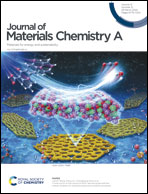Modulating coal-derived carbon toward electrocatalytic generation of hydroxyl radicals for organic contaminant removal†
Abstract
The three-electron oxygen reduction reaction (3e− ORR), which consists of the electrochemical production of hydrogen peroxide (H2O2) and the subsequent activation, allows for the facile generation of hydroxyl radicals (˙OH) for environmental remediation. However, the current understanding on designing the corresponding electrocatalyst is not adequate. Herein, carbon-based electrocatalysts are prepared using bituminous coal as the raw material to obtain a high content of oxygen, which is crucial for H2O2 production, and the oxygen-containing functional groups (OFGs) in the electrocatalyst are modulated to improve the ˙OH production efficiency. Experimental and calculation results demonstrate that C![[double bond, length as m-dash]](https://www.rsc.org/images/entities/char_e001.gif) O groups serve as active sites for not only H2O2 formation but also the activation of H2O2 to produce ˙OH, while H2O2 desorption and H2O2 activation are more favorable at COOH and C
O groups serve as active sites for not only H2O2 formation but also the activation of H2O2 to produce ˙OH, while H2O2 desorption and H2O2 activation are more favorable at COOH and C![[double bond, length as m-dash]](https://www.rsc.org/images/entities/char_e001.gif) O sites, respectively. Therefore, after deliberately removing COOH groups from the coal-derived carbon surface, the ˙OH production efficiency is increased, leading to the fast removal of organic dyes from water. Our results demonstrate the significance of modulating the surface OFGs on the carbon-based electrocatalyst toward efficient ˙OH production from the 3e− ORR, which provides a green and sustainable route toward organic contaminant removal from water.
O sites, respectively. Therefore, after deliberately removing COOH groups from the coal-derived carbon surface, the ˙OH production efficiency is increased, leading to the fast removal of organic dyes from water. Our results demonstrate the significance of modulating the surface OFGs on the carbon-based electrocatalyst toward efficient ˙OH production from the 3e− ORR, which provides a green and sustainable route toward organic contaminant removal from water.



 Please wait while we load your content...
Please wait while we load your content...